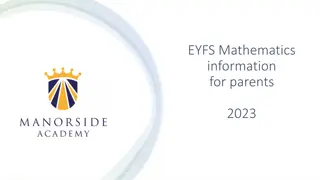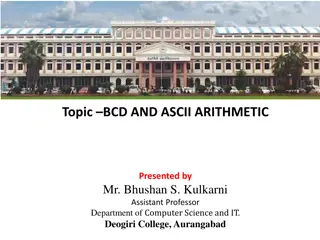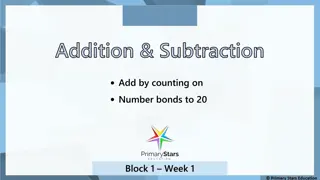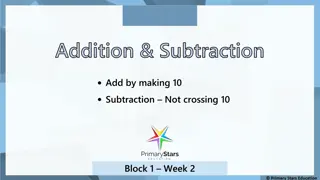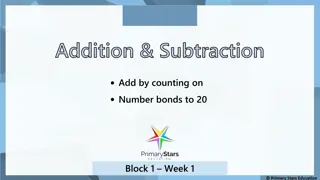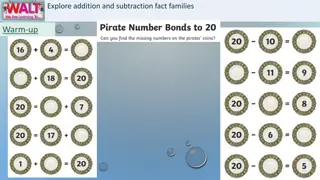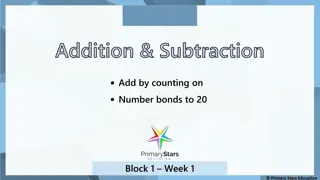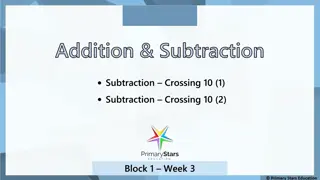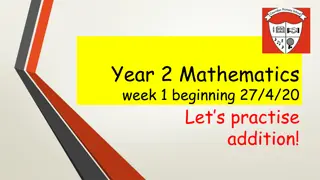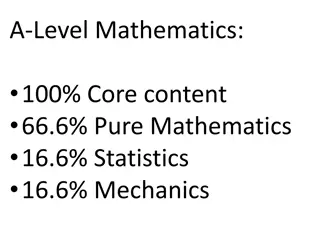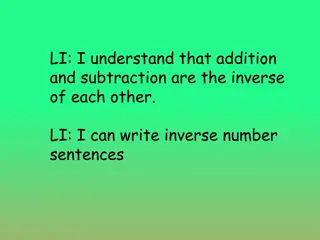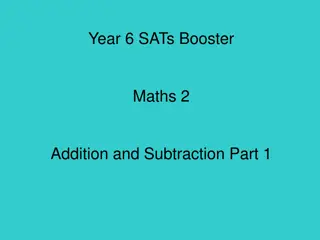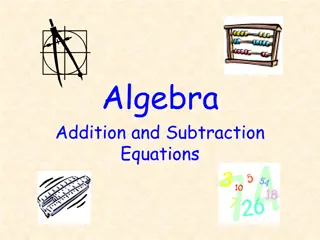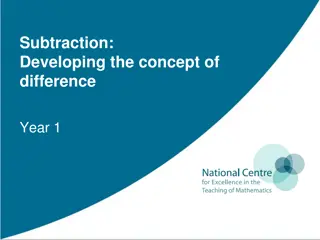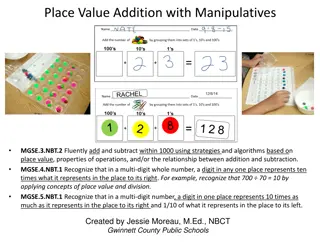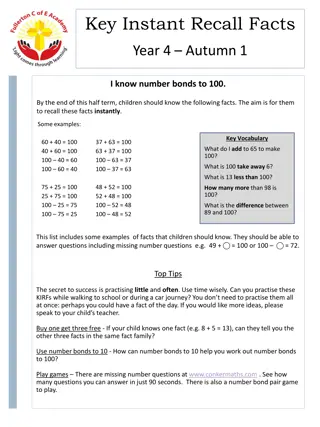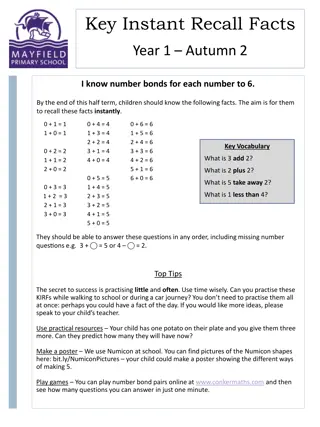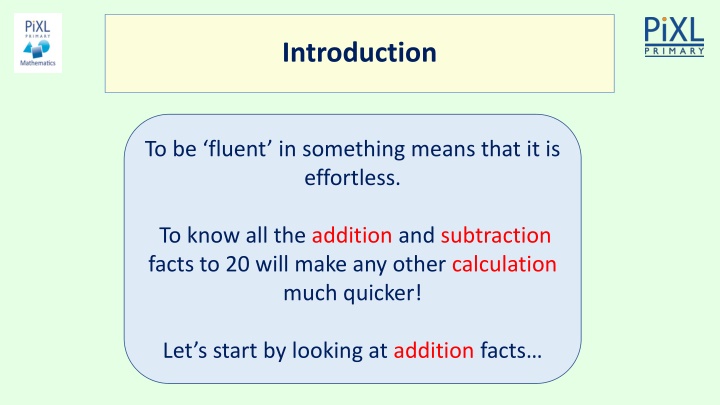
Mastering Addition Facts to Enhance Mathematical Fluency
Learn how to master addition facts up to 20 effortlessly through a systematic approach. Discover the importance of being systematic, patterns in addition calculations, and the use of bar models to enhance understanding. Practice finding pairs of numbers that add up to 20 and improve your mathematical skills today!
Download Presentation

Please find below an Image/Link to download the presentation.
The content on the website is provided AS IS for your information and personal use only. It may not be sold, licensed, or shared on other websites without obtaining consent from the author. If you encounter any issues during the download, it is possible that the publisher has removed the file from their server.
You are allowed to download the files provided on this website for personal or commercial use, subject to the condition that they are used lawfully. All files are the property of their respective owners.
The content on the website is provided AS IS for your information and personal use only. It may not be sold, licensed, or shared on other websites without obtaining consent from the author.
E N D
Presentation Transcript
Introduction To be fluent in something means that it is effortless. To know all the addition and subtraction facts to 20 will make any other calculation much quicker! Let s start by looking at addition facts
Addition Talk to your partner How many different pairs of numbers can you think of that total 16? 16
Being systematic How did you do? When trying to list all the possibilities, a systematic approach is needed. It means that you do something in a specific order to avoid confusion or repeating yourself. It allows you to make sure you have found every possibility. 16
Being systematic Totalling 16 15 14 13 12 11 16 1 2 3 4 5 + + + + + + + = = = = = = = 16 16 16 16 16 16 16 Decrease by 1 each time Increase by 1 each time Can you see any patterns? What would be the next 3 combinations? 6 10 9 7 Work with a partner to find all of the remaining combinations.
Being systematic 4 + 12 = 16 12 + 4 = 16 What do you notice about these calculations? This reminds us that addition is the same whichever way round the numbers are placed. So, if we know that 12 + 4 = 16, we also know that 4 + 12 = 16. This means we only have to remember half the facts!
Your turn Paired task Using a systematic approach, can you find all the pairs of numbers that, when added, equal 20? 20 Remember, there is no need to list the same calculation twice. For example: if 1 + 19 = 20 then 19 + 1 = 20.
Bar models 18 Bar models can show how two numbers are added to make a total. Let s look at an example. a b This shows that a number (a) added to another number (b) makes a total of 18. This can be written as a number sentence or equation. a + b = 18
Bar models 18 Think carefully about the size of the bars compared to each other. a b Write down two numbers that a and b could represent. a = 12 b = 6 12 + 6 = 18 a = 13 b = 5 13 + 5 = 18 Possible solutions:
Bar models 18 9 9 We know from the size of the bar a compared to bar b that the number represented by a must be bigger than b . a b Jake says that one solution is: a = 2 and b = 16 Explain why this could not be a solution. We also know that half of 18 is 9, so, if we mark the half- way point, this helps us more accurately estimate the size of the numbers.
Your turn 12 For each bar model: 1. Write down two combinations of numbers that a and b could be based on the size of the bars. 2. Write down two combinations of numbers that a and b could not be based on the size of the bars. a b 20 a b Try marking half way and writing in half of each number on the top bar.
Your turn Tara and Adam decided to share the cost of some new table tennis bats. If Tara paid 12, how much would Adam have to pay? Only 20 What if they paid half each?
Subtraction For example: If you know that 15 + 5 = 20 then you also know that 20 5 = 15. As for recalling subtraction facts, most of the hard work has been done for you whilst finding the addition facts! Addition is the inverse of subtraction: inverse just means opposite!
Finding subtraction facts How can we use the addition calculation below to find subtraction facts? Let s look at this together. 10 6 = 4 4 + 6 = 10 If I know that: Then I also know this: 10 4 = 6 6 + 4 = 10
Your turn Use the calculation below to find subtraction facts. 5 + 7 = 12 5 + 7 = 12 12 7= 5 If I know that: Then I also know this: 12 5 = 7 7 + 5 = 12
Fact families 5 + 7 = 12 12 7= 5 Talk to your partner Does the order in which you put the numbers matter for every calculation? 7 + 5 = 12 12 5 = 7
Fact families 5 + 7 = 12 12 7= 5 Talk to your partner What do you notice about the position of the numbers in the addition calculation compared to the subtraction calculation? 7 + 5 = 12 12 5 = 7
Recalling subtraction facts 17 2 15 Which subtraction calculations are shown by this bar model? 17 2 = 15 17 15 = 2
Your turn 14 5 9 Which subtraction calculations are shown by this bar model?
Missing number problems 20 a 15 Being able to recall addition and subtraction facts helps us to find missing numbers. How could you work out the missing number?
Missing number problems 20 a 15 If we know that 20 15 = 5 then we know that a must be 5. Check the solution with the inverse. 5 + 15 = 20
Your turn Use your known facts to find the missing number in each bar model. Write down the inverse calculation you would use to check your solution. 15 20 9 b a 12
Your turn Insert >, < or = to make these statements true. One has been done for you. 5 + 10 12 + 6 8 + 2 20 14 13 + 6 18 8 = 11 + 4 13 + 7 12 4 10 + 6 12 + 8 20 10
Your turn Members of Class 3T receive a certificate when they achieve 20 merit points. Ms Thomas keeps a record of the number of merits each pupil has. Use your addition and subtraction facts to complete the missing numbers in Ms Thomas record on the next slide.
Your turn Name Number of merits earned 12 6 Number of merits still needed Kira Tom Sapna Josh Emma Leroy Becky 3 11 15 8 1
Remember Knowing number facts within 20 helps you to calculate more quickly. Knowing addition facts means that you can find the related subtraction facts, because addition and subtraction are inverse operations. Knowing these facts helps to solve problems like missing numbers. When trying to find all possibilities, it is a good idea to work systematically to make sure solutions are not missed.

